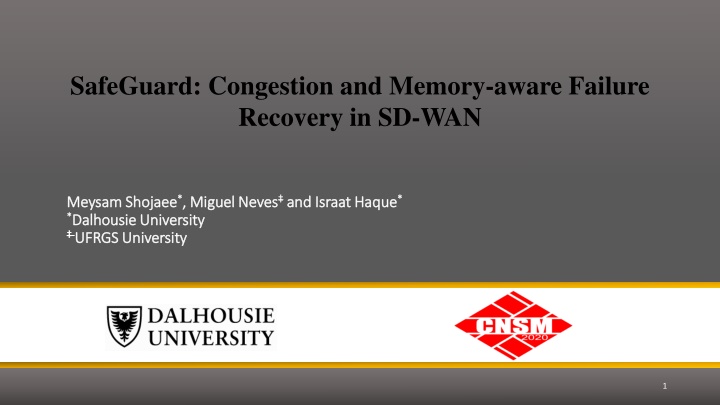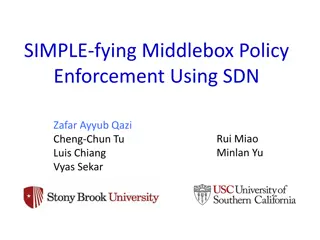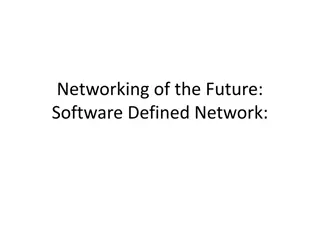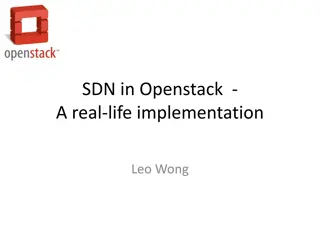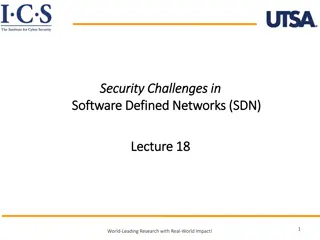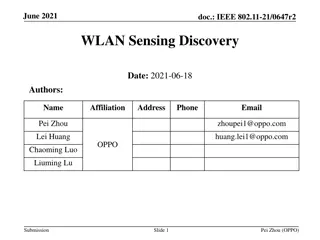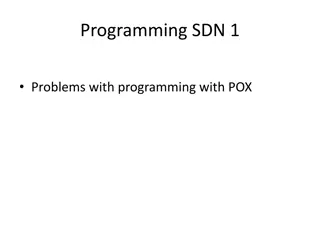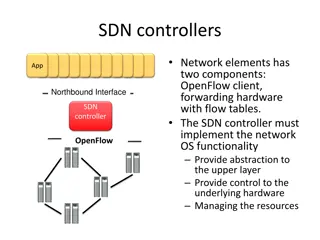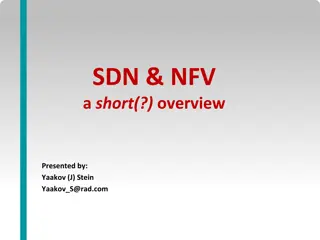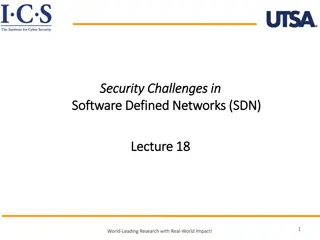SDN Concepts and OpenFlow: Workshop Highlights and Fundamentals
Delve into the important topics covered at the UCF/FLR Workshop on Networking, focusing on Software-Defined Networking (SDN) concepts, Open vSwitch, OpenFlow protocol, plane separation, SDN operation, and how SDN works. Understand the fundamentals of SDN, including data and control planes, limitations, and the components involved in SDN architecture. Explore the separation of data and control planes, the functionality of the data plane, and the role of the control plane in a centralized controller setup. Gain insights into SDN operation, including SDN switches, controllers, applications, and the flow table structure. Prepare to enhance your knowledge and expertise in SDN technologies.
Download Presentation

Please find below an Image/Link to download the presentation.
The content on the website is provided AS IS for your information and personal use only. It may not be sold, licensed, or shared on other websites without obtaining consent from the author.If you encounter any issues during the download, it is possible that the publisher has removed the file from their server.
You are allowed to download the files provided on this website for personal or commercial use, subject to the condition that they are used lawfully. All files are the property of their respective owners.
The content on the website is provided AS IS for your information and personal use only. It may not be sold, licensed, or shared on other websites without obtaining consent from the author.
E N D
Presentation Transcript
SafeGuard: Congestion and Memory-aware Failure Recovery in SD-WAN Meysam Shojaee Meysam Shojaee* *, Miguel Neves * *Dalhousie University Dalhousie University UFRGS University UFRGS University , Miguel Neves and Israat Haque and Israat Haque* * 1
Outline SD-WANs and network failure 1 Failure recovery challenges 2 SafeGuard s model and architecture 3 Results analysis 4 Conclusion 5 2
SDN deployment examples B4: Google s private SD-WAN [2] Large service providers such as Amazon, Facebook, Google, and Microsoft are deploying SDN in their WAN [1]. University, Halifax, Canada Institute of Informatics, UFRGS, Brazil Network failures are common in wide area networks [3]. 80% of the network component failures last from 10 to 100 minutes which leads to intensive packet loss [4]. 3
Why failure recovery is challenging is SD-WAN? This route is prone to congestion ?1 Providing short backup routes conflicts with making a balanced link utilization x ?3 ?4 ?5 Shortest route failed Bandwidth capacity of links are limited The memory of the switches are limited The route and traffic rate need to be configured in small Traffic Engineering (TE) cycles TCAMs are well-known to be power- hungry and to have limited capacity [5] 4
Problem formulation We formulated the failure recovery problem as a multi-objective MILP optimization problem Minimizing the maximum link utilization Objectives Minimizing the backup route length Objective function: 1 2 Term 1: The length of the backup route Term 2: The load on each link 5
Constraints of the designed model We have considered a number of constrains in our model: 3. Flow satisfaction 1. Link bandwidth capacity 2. Switch memory capacity It takes more than one hour to solve the model in CPLEX The model is an MILP problem which is known to be NP-hard We developed a heuristic to solve it in a reasonable time 6
Operation of the heuristic Key ideas of the heuristic: 1) Assigns the larger flows to the shorter routes first 2) When get to the memory usage threshold: best-fit strategy is applied Both flows are affected by the failure ?1 from switch ?1 to ?5 has a demand of 25Mbps 15 Mbps X ?1 ?3 ?5 ?2 from switch ?2 to ?5 requires 20Mbps 10Mbps The remaining capacity of all links after the allocation of the flows: 20Mbps except link ?4 ?5 whose capacity is 5Mbps ?4 ?2 ?6 10Mbps 7
Operation of the heuristic 10Mbps X ?1 ?3 ?5 routes are allocated to ?1 with higher demand ?4 ?2 ?6 X ?1 ?3 ?5 10Mbps routes are allocated to ?2 after ?1 ?4 ?2 ?6 10Mbps 8
SafeGuards architecture o Input: a traffic matrix, the network topology, and a set of forwarding routes (primary routes) o Produces a primary allocation that will be used for forwarding traffic under normal conditions o SafeGuard then applies the heuristic to augment the primary allocation with backup routes for all flows for each possible single link failure. 9
SafeGuards work-flow Step A: SafeGuard computes and installs all primary tunnels and splitting weights for every flow Step B: proactively installs backup routes and computes the weights for allocated flows Step C: When a failure happens: the failing switch activates the corresponding backup tunnels sends a message reporting the failure to the network controller Step D: the network controller adjusts splitting weights for all affected flows at their respective ingress switches. 10
Evaluation setup Implementation: We implemented a prototype of SafeGuard using the Ryu SDN controller Each node is implemented as a CpqD switch instance Link capacities are set to 1 Gbps https://github.com/M eysam-Sh/SafeGuard Network topologies: We considered two networks: B4 with 12 nodes and ATT with 25 nodes Data generation: We used Iperf tool to generate UDP traffic We randomly failed a link in the network 11
Results 48% SafeGuard: 48% of the links are under 80%+ load 57% Sentinel: 57% of links are under 80% + load SafeGuard results in backup routes around 10% shorter than Sentinel 12
Conclusion SDN is widespread in the production networks. The link failures are a common occurrence in SD-WANs. We formulated the failure recovery problem as a multi-objective MILP optimization problem. We designed and developed a heuristic as the problem was NP-hard. We implemented a prototype of SafeGuard using the Ryu SDN controller and evaluated it in Mininet. Our results show that SafeGuard can reduce the number of congested links by up to 50% compared to the state-of-the-art failure recovery scheme. 13
References: [1] Software-defined networking: The new norm for networks, Open Netw. Found., Palo Alto, CA, USA, ONF White Paper, 2012. [2] Feamster, N., Rexford, J., & Zegura, E. (2014). The road to SDN: an intellectual history of programmable networks. ACM SIGCOMM Computer Communication Review, 44(2), 87-98. [3] A. Markopoulou, G. Iannaccone, S. Bhattacharyya, C.-N. Chuah, and C. Diot, Characterization of failures in an IP backbone, in IEEEInternational Conference on Computer Communications (INFOCOM). IEEE, 2004 [4] R. Govindan, I. Minei, M. Kallahalla, B. Koley, and A. Vahdat, Evolve or Die: High-availability design principles drawn from googles network infrastructure, in Proceedings of the 2016 ACM SIGCOMM Conference, ser. SIGCOMM 16, 2016, pp. 58 72 [5] Mohan, P. M., Truong-Huu, T., & Gurusamy, M. (2015, December). TCAM-aware local rerouting for fast and efficient failure recovery in software defined networks. In 2015 IEEE Global Communications Conference (GLOBECOM) (pp. 1-6). IEEE. [6] Li, J., Hyun, J., Yoo, J. H., Baik, S., & Hong, J. W. K. (2014, May). Scalable failover method for data center networks using OpenFlow. In 2014 IEEE Network Operations and Management Symposium (NOMS) (pp. 1-6). IEEE. [7] https://cogentco.com/en/network/network-map 20
